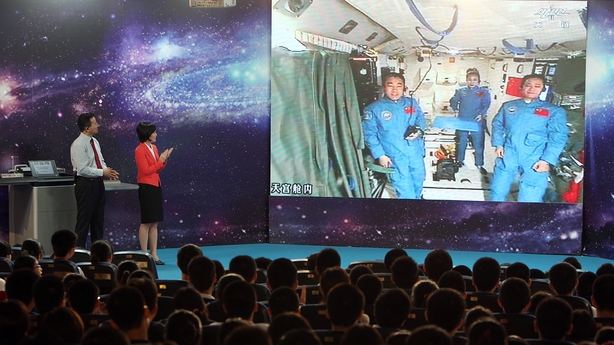An out-of-control space laboratory that will plunge back to Earth in the coming days is unlikely to cause any damage, Chinese authorities say, but will offer instead a "splendid" show akin to a meteor shower.
China's space agency said that the nearly eight-tonne Tiangong-1 will re-enter the atmosphere some time between tomorrow and Monday.
The European Space Agency has a smaller window between midday tomorrow and early Sunday afternoon Irish time.
But there is "no need for people to worry", the China Manned Space Engineering Office (CMSEO) said on its WeChat social media account.
Such falling spacecraft do "not crash into the Earth fiercely like in sci-fi movies, but turn into a splendid (meteor shower) and move across the beautiful starry sky as they race towards the Earth", it said.
The lab was placed in orbit in September 2011 and had been slated for a controlled re-entry, but it ceased functioning in March 2016 and space enthusiasts have been bracing for its fiery return.
China sees its multi-billion-dollar space programme as a symbol of the country's rise.
It plans to send a manned mission to the moon in the future.
China sent another lab into orbit, the Tiangong-2, in September 2016 and hopes to turn it into a crewed space station by 2022.

Experts have downplayed any concerns about the Tiangong-1 causing any damage when it hurtles back to Earth, with the ESA noting that nearly 6,000 uncontrolled re-entries of large objects have occurred over the past 60 years without harming anyone.
The CMSEO said the probability of someone being hit by a meteorite of more than 200 grammes is one in 700 million.
During the uncontrolled re-entry, atmospheric drag will rip away solar arrays, antennas and other external components at an altitude of around 100km, according to the Chinese space office.
The intensifying heat and friction will cause the main structure to burn or blow up, and it should disintegrate at an altitude of around 80km, it said.
Most fragments will dissipate in the air and a small amount of debris will fall relatively slowly before landing, most likely in the ocean.
An out-of-control space laboratory that will plunge back to Earth in the coming days is unlikely to cause any damage, China says https://t.co/af5uZAAifL pic.twitter.com/nn4tCau24H
— AFP news agency (@AFP) March 30, 2018
Jonathan McDowell, an astronomer at the Harvard-Smithsonian Center for Astrophysics, estimates that the Tiangong-1 is the 50th most massive uncontrolled re-entry of an object since 1957.
"Much bigger things have come down with no casualties," he said.
"This thing is like a small plane crash," he said, adding that the trail of debris will scatter pieces several hundred kilometres apart.
At an altitude of 60-70km, debris will begin to turn into "a series of fireballs", which is when people on the ground will "see a spectacular show", he said.
Space expert, Leo Enright says China's Tiangong-1 space station will fall from space over the weekendhttps://t.co/J8ksZuaWXX
— Morning Ireland (@morningireland) March 30, 2018

